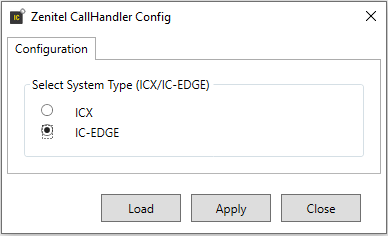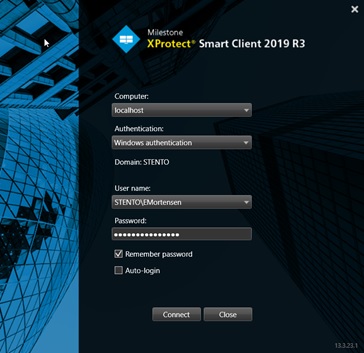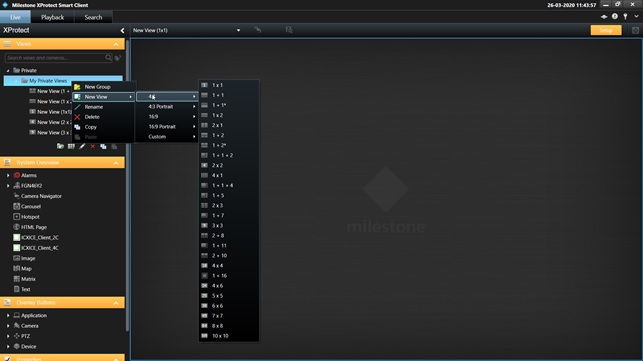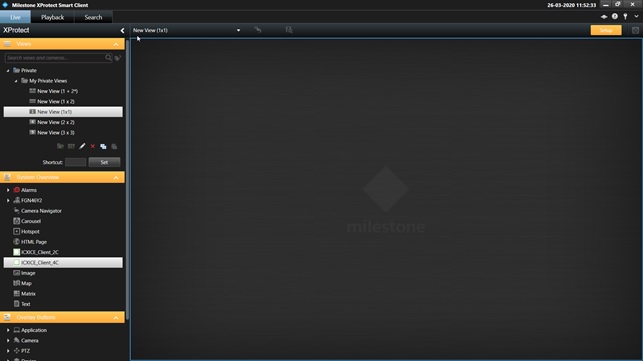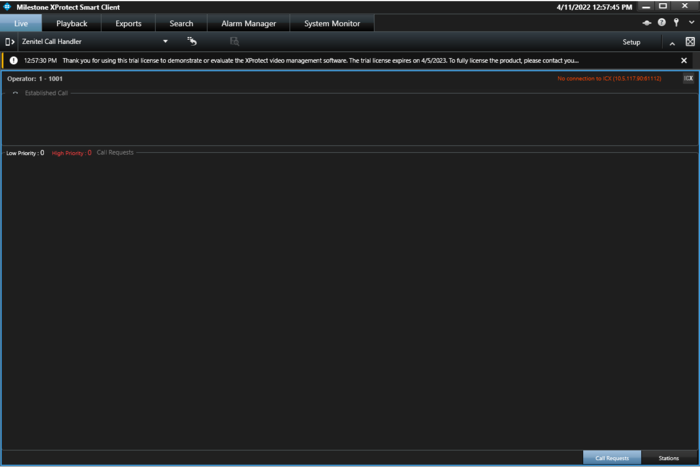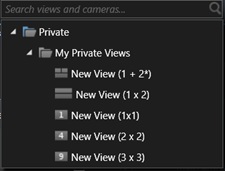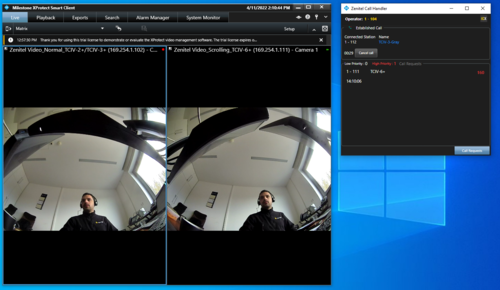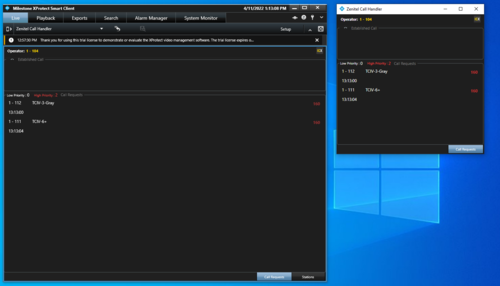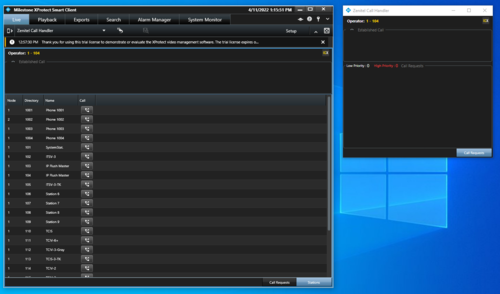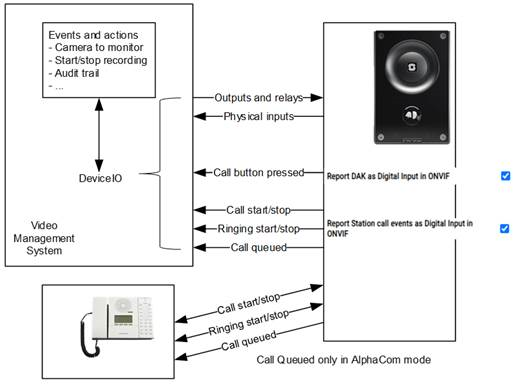Milestone Xprotect - IC-Edge Integration (Zenitel Call Handler)
From Zenitel Wiki
Introduction

|
This product is discontinued. For configuration of the latest plugin for integration with Milestone Xprotect go to Milestone XProtect - IC-Edge Integration |
This article assumes that the reader is
- familiar with setup and operation of the Milestone XProtect VMS
- that the Milestone XProtect VMS is operational, with all the system connected cameras configured
Only points that are specific to this integration and to its connected intercom stations are described.
Overview
Zenitel devices can be integrated into the Milestone XProtect system using their ONVIF capabilities and supplemented with the Zenitel Call Handler plugin.
ONVIF benefits:
- Auto discover devices in the Milestone XProtect VMS, ensuring easy integration.
- Display Zenitel device video feed in the Milestone XProtect VMS on various events like a call request, outgoing call, or pressed DAK button.
- Display Camera on a call connection, allowing the operator to see who he is talking to.
- Record audio and video during a conversation.
- Write a log entry for the audit trail on various events like starting a conversation, opening a door, motion detection, etc.
Benefits of Zenitel Call Handler:
- Pops up above all opened windows and displays all incoming (queued) and outgoing calls.
- Allows the operator to accept queued calls and close opened call connections without opening the plugin inside the Milestone XProtect VMS.
Compatibility
- Milestone XProtect Smart Client 2019 R3 and higher
- ICX: 1.0.3.1 and higher
- AlphaCom: 13.1.3.3 and higher
Licensing
Zenitel devices can be used using their ONVIF capabilities without a specific integration license from Zenitel.
The use of the call handler plugin is licensed as detailed below.
IC-EDGE
Milestone license
Using the integration plug-in module does not require a specific license from Milestone.
For connection of devices to Milestone XProtect, please contact Milestone directly.
ONVIF Integration
Zenitel devices are recognized in the Milestone XProtect system as ONVIF compatible devices and are added to the system in the same way.
Note: audio-only devices are also recognized as ONVIF devices.
Supported Devices
Video Intercoms
- Turbine Video intercom and kit: TCIV+
- Turbine Video kit: TKIV+
- Turbine Video intercom TCIV (previous generation of Zenitel video intercom devices)
Non-Video Intercoms
- Turbine Compact series TCIS
- Turbine Industrial series TFIE
- Turbine kits TKIE and TKIS
- EX intercoms series TFIX
- V2 Master Stations
- IP Speakers
Pre-requisites
- VS-IS 6.4.3.0 or later must be installed in the Zenitel Device
- The latest XProtect Device Pack must be installed.
ONVIF configuration
Some ONVIF settings are available from the station web interface where the user needs to enable reporting DAKs and digital inputs in ONVIF.
The user can configure digital inputs to trigger various behaviors in XProtect, most notably:
- Set the Matrix to view the device video
- Start recording video/audio
- Write an entry in the audit trail log
- Trigger a pre-recorded audio message
- Trigger an alarm
More information on this topic can be found in the ONVIF article.
Using the Matrix
1. The user has to create a matrix in the Milestone Management Client.
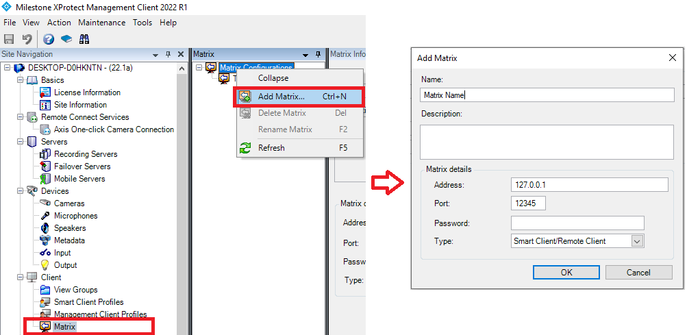
2. After configuring the matrix the user has to add it to a view in the XProtect Smart Client
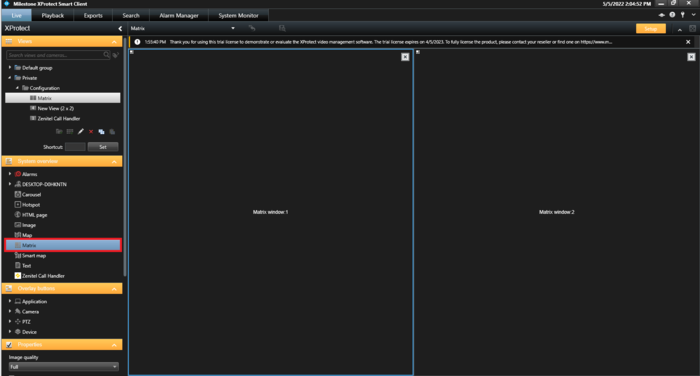
3. After the matrix has been set up the user has to configure the rule system in the XProtect Management System to push the device video to the matrix.
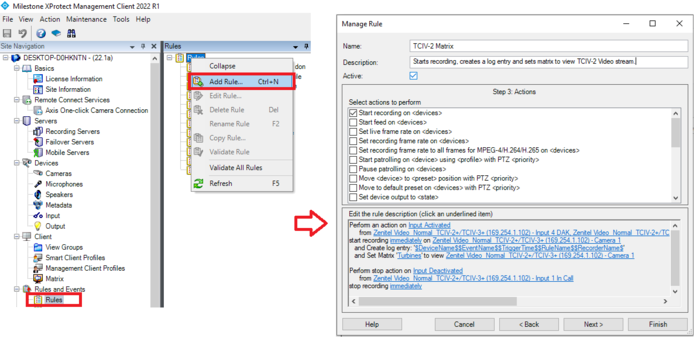
More information on the matrix can be found in the official Milestone documentation
Milestone Matrix (usage)
Milestone Matrix (configuration)
Alarm configuration
On the Milestone XProtect VMS server, virtually any kind of incident or technical problem - events - can be set up to trigger an alarm. Alarms and events can all be viewed on the Alarm Manager tab, which provides a central overview of your Milestone XProtect VMS incidents, status, and possible technical problems.
The following images show a detailed overview of the XProtect alarm system:
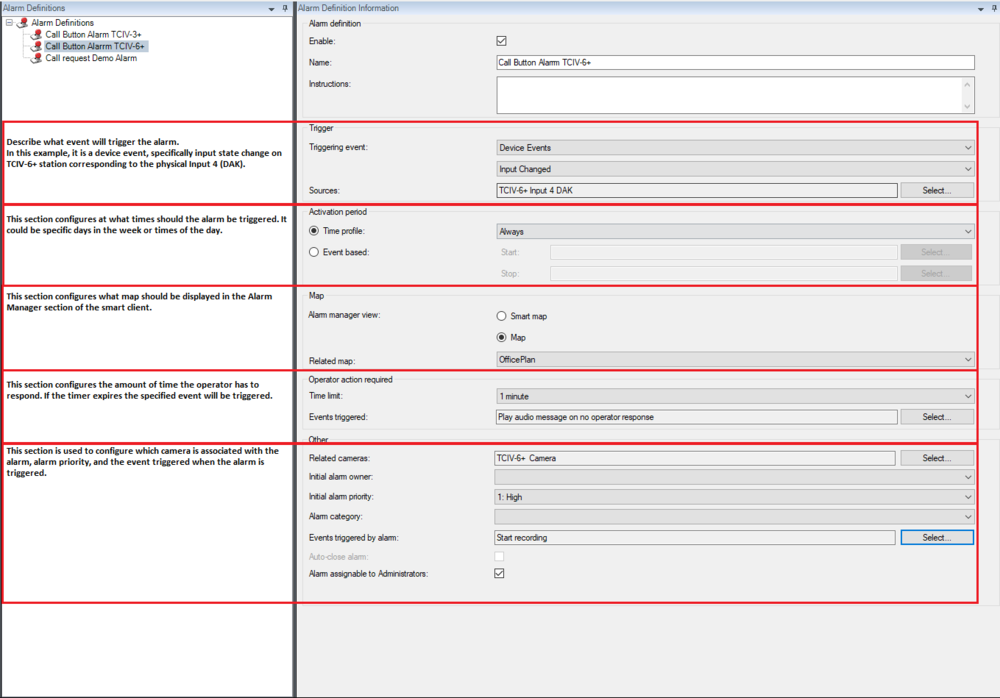
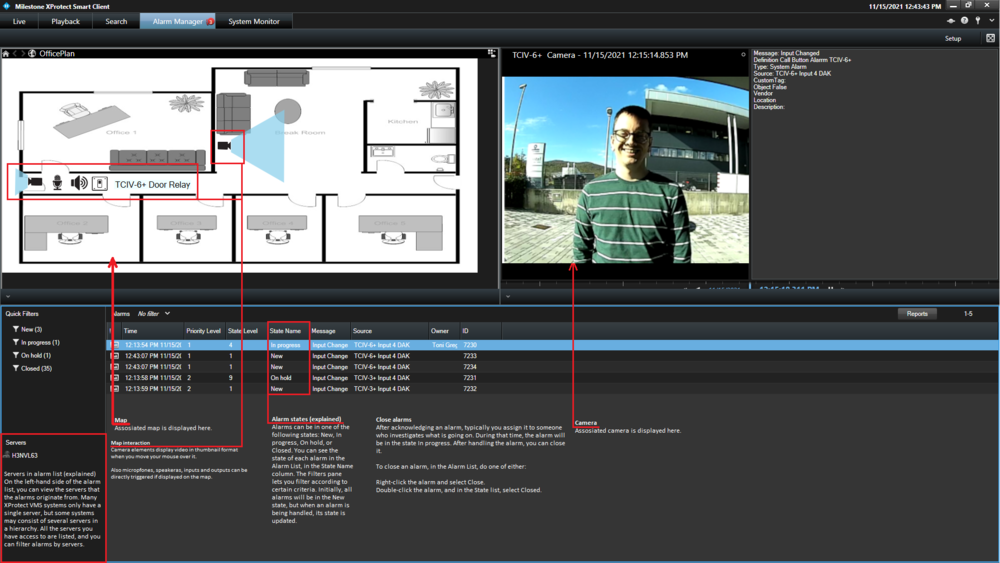
Full size images can be found here:
More information on the alarm system can be found in the official Milestone documentation
Milestone Alarms and events (usage)
Zenitel Call Handler plugin installation
This section describes how to install the integration plugin.
It is assumed that the Milestone XProtect VMS has been installed and is running.
Prerequisite
The integration plugin uses .NET 4.8. Please make certain that this version of the .NET framework is installed prior to installing the interface module itself.
Milestone Management Client / Smart Client
When installing (or uninstalling) the plugin, all Milestone Clients (Management Client and Smart Client) must be closed.
Plugin Installation
The name of the installation file is Zenitel-CallHandler.x.x.x.x.exe, where x.x.x.x is the version number. Double click the exe-file to start the installation procedure. Click through the installation option screens, make the appropriate choices, and select Install to do the actual plugin installation.
The plugin will be installed in the directory C:\Windows\Program Files(x86)\Zenitel\Zenitel Call Handler
Plugin Setup
The installation in Milestone XProtect VMS is carried out by starting the program Zenitel.CallHandler.Plugin.Config.exe:
Select the type of system (ICX/IC-EDGE). Press “Apply” to execute the update. The program can also be used for changing the system type in which case you press “Load” – make the system change – and press “Apply”.
- ICX - Select ICX also if the system to be integrated is AlphaCom XE
- IC-EDGE - Selects IC-EDGE system (in the rest of this article only reference will be made to IC-EDGE, but the operation is the same for AlphaCom XE and ICX)
Milestone XProtect Smart Client
The Milestone XProtect Smart Client is started in the following way:
- Ensure the three servers - management, event, and recording - are up and running. This can be checked by viewing the taskbar. All icons should be shown with a green indicator.

- Click on icon
 and wait until the following picture will be shown:
and wait until the following picture will be shown:
Press “Connect” and wait until the Milestone XProtect Client is started.
Ensure that the “Setup” button in the upper right corner is turned on with an orange background as shown. The Milestone Xprotect VMS is now in setup mode. It is now possible to define different views with different partitioning (split). For the test, it would be appropriate to create a (1 x 1) view (see picture above).
Select the (1*1) view and and drag and drop the “Zenitel Call Handler” plugin onto the view.
Press the orange "Setup" button.
You may push “<” in the panel ![]() to hide the left side panel.
to hide the left side panel.
You can easily switch between views by activating the “v” in the panel.
![]() and select the desired view from the list:
and select the desired view from the list:
The ICXICE-Client is now in setup mode. Switching between “Setup” and “Operation” is done by a single left click on the icon ![]()
Operation
Popup window
As soon as a call is queued the popup window will be opened. Popup windows will be drawn on top of any other open window and persist as the topmost window until manually closed. This way the operator can use the VMS to view video from the stations and the popup window to answer calls.
Usage
The main TAB in operational mode is the Call Requests-TAB.
All call requests are listed in order of priority in the Call Requests-list; the time when the call request entered the list is shown below the station identification.
An established call is shown in the top section of the TAB and in the popup window. A timer shows how long the conversation has been going on.
The Stations-TAB allows the selection of stations for directly calling them through the Milestone XProtect VMS. Clicking on the call icon will establish a call with the selected station and immediately open the popup window. NOTE: The popup window lacks the station tab to place calls from the Milestone XProtect VMS. More on stations tabs in the Usage section below.
Additional Information
All Zenitel devices with a camera (TCIV and TCIV+) are certified to ONVIF Profile S. This allows the stations to be discovered by Milestone XProtect. As from VS-IS software version 6.4.3.0, a number of additional capabilities have been added:
- Support for DeviceIO
- Audio Backchannel, meaning audio from Milestone XProtect VMS to the device
In addition, some other major changes have been made:
- Audio only stations which can run VS-IS 6.4.3.0 are now able to generate a video stream and are therefore compliant with ONVIF Profile S
- As a further enhancement to DeviceIO, station modes are made available as a logical input to the Milestone XProtect VMS and can then trigger function in that Milestone XProtect VMS
Non-Video Intercom stations as ONVIF Profile S compliant devices
The stations generate a video stream (a Zenitel logo) and can be discovered as any other camera. As with the TCIV and TCIV+, the microphone is also discovered as a camera capability.
Audio backchannel
Milestone XProtect will also discover the presence of the station's loudspeaker. This then gives the possibility for the Milestone XProtect VMS operator to directly send a voice message to the station. This would normally be used when the same message needs to be broadcast to all cameras featuring a loudspeaker and which cannot be reached in the normal Zenitel way, as they are not part of an ICX-AlphaCom, IC-EDGE or SIP system.
DeviceIO
VMS's which support this ONVIF feature will be able to discover the presence of all inputs and outputs on the station, this includes Milestone XProtect VMS. Inputs can be used to trigger actions in the Milestone XProtect VMS event handler. Control of the outputs can be triggered directly by the operator, or as an action from the Milestone XProtect VMS event handler.
Report DAK as Digital Input in ONVIF
Other than the general-purpose inputs which are available on the station, it is possible to have a DAK-button press reported as an input to the Milestone XProtect VMS. This can for instance be used as an additional way of signaling that there is somebody at the door, wanting to talk to the operator. (Turbine stations only, TCIS and TCIV+)
Report station call events as Digital Input in ONVIF
Stations know the state they are in: in a call, ringing, in call requester mode. This state information is now available to the ONVIF module in the station software and can be used to provide a number of additional 'virtual' inputs. These inputs are discovered through DeviceIO, in the way any physical input is discovered. States that can be signaled to Milestone XProtect are:
- Call established - Call in progress input Activated
- Call ended - Call in progress input Deactivated
- Station in ringing mode - both for an outgoing (ringback) and incoming call - Call ringing input Activated
- Station ringing mode ended - Call ringing input Deactivated
- Station has made a call request or ringing group call (only when the station is in AlphaCom mode) - Call queued input Activated
- Station leaves call request or ringing group call mode (only when the station is in AlphaCom mode) - Call queued input Deactivated
Use cases that can be solved by these inputs are:
- Switching a camera to a monitor pane at the start of a conversation
- Starting and stopping video and/or audio recording
- Adding an entry in a the log for audit trail purposes
The order of inputs being reported
The following order, from first to last, is used to report the different inputs if enabled and available.
- Call Active
- Call Queued
- Call Ringing
- DAK 1....n
- Inputs 1....n



